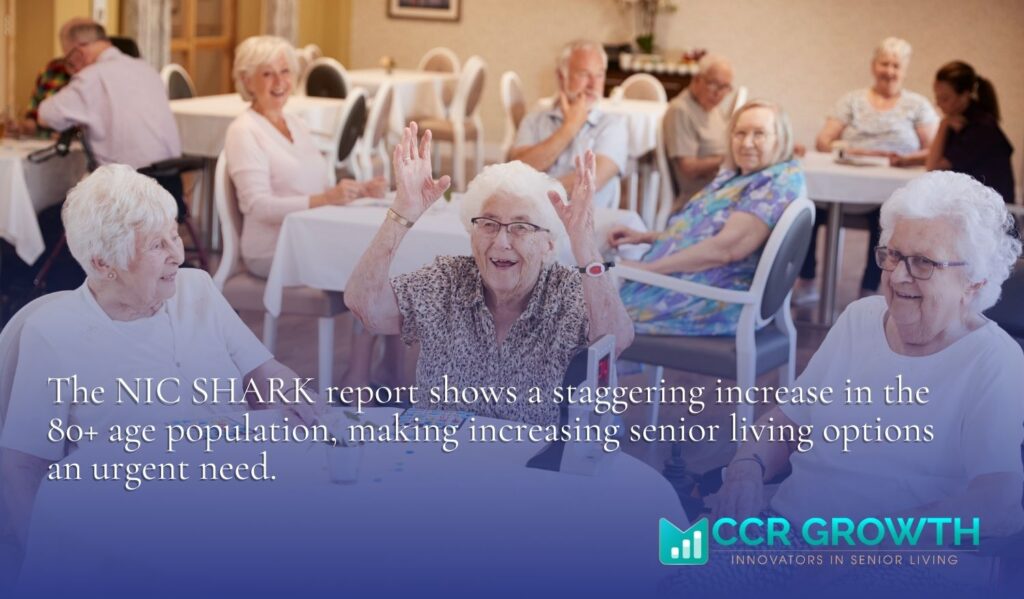
CCR Growth
Is Senior Housing Heading for Boom or Bust?
The senior living sector stands at a crossroads. Demographic trends point to a surge in demand for housing options, fueled by a rapidly growing population of older adults. Yet, a critical supply shortage threatens to limit the sector’s ability to meet this need. This potential crisis is the focus of episode 06 of From Leads to Leases, a podcast hosted by Jerry Vinci, CEO of CCR Growth. In this episode, Jerry delves into the findings of the first segment of the NIC SHARK report series, a forward-looking analysis of the senior housing market’s fundamentals from 2024 to 2026.

A Looming Shortage: Construction Lags Behind Demand
“The construction landscape for senior living facilities is at a critical juncture,” CEO of CCR Growth Jerry Vinci warns in an episode of From Leads to Leases. While some regions show signs of increased activity, the overall pace of new construction falls short of the rising demand. “The reality is that even with all cylinders firing, the projected pace of new constructions is barely keeping up,” observes Jerry. According to the report, even if all current projects are completed within the next three years, the projected inventory increase would only be 4.1%, translating to roughly 44,000 units.
This falls far short of the anticipated demand growth, leaving a significant gap. This lag in development is attributed to a cocktail of challenges: high construction costs, labor shortages, and regulatory hurdles. In the podcast episode, Jerry emphasizes, “These challenges aren’t just bumps in the road; they’re potential roadblocks that could stymie the growth of the senior living industry if not addressed.” The NIC SHARK report further emphasizes this point, highlighting the increasing cost of senior living development. Mid-level independent living and assisted living building costs have jumped by 16% since June 2022, while high-level independent living development costs have skyrocketed by 21%.

The 80+ Age Group Booms
The demand for senior housing is driven by a powerful demographic force: the rapid growth of the 80+ population. The NIC SHARK report projects a staggering 34% increase in this age group within the next six years. “This demographic shift signals an urgent need for our industry to rethink capacity and scalability,” Jerry stresses.
Solutions for a Sustainable Future
With the current development pace failing to meet the demand, the senior living sector needs innovative solutions. In the podcast episode, Jerry outlines several promising approaches:
- Accelerated Construction Techniques: Modular construction, involving prefabricated building sections, offers a faster and more cost-effective alternative to traditional methods. This approach can significantly reduce construction timelines and labor costs, getting communities ready for residents sooner.
- Repurposing Existing Buildings: Transforming hotels, office spaces, or schools into senior living communities can be a practical and creative solution. This approach leverages existing structures, often in desirable locations, while minimizing construction time and environmental impact. Citing a 2023 NIC study, Jerry points out that “about 41% of senior housing communities are more than 25 years old.” This vast existing inventory presents a significant opportunity for renovation and repurposing.
- Financial Incentives: Encouraging investment in senior housing development could involve tax breaks, easier access to low-interest loans, and specific development grants. These financial motivators would make senior housing projects more attractive to developers and accelerate the creation of new units.
- Streamlining Regulations: Simplifying the regulatory framework can expedite the development process. Faster zoning approvals, reduced red tape on land use, and clearer guidelines could significantly reduce the time it takes to get projects from concept to completion.
- Technological Advancements: Integrating smart home technology and leveraging AI and machine learning can optimize facility management and care delivery. These advancements can enhance residents’ independence and create a more sustainable and adaptable living environment.
Rising Occupancy Rates
Despite the supply concerns, there are positive signs. Occupancy rates in senior living communities are projected to rise significantly, with the NIC SHARK report indicating a growth of 8% to 14% in occupied stock from 2023 to 2026. This is two to three times the projected inventory growth. “We’ve seen a robust recovery post-pandemic, with many regions not just bouncing back but setting new benchmarks,” Jerry observes. This rising occupancy reflects a strong and sustained demand for senior living options.

Balancing Occupancy with Availability
While high occupancy rates are generally positive, they also raise concerns about limited availability. With regions approaching maximum capacity by 2026, the sector risks a shortage of options for older adults seeking housing. “This is where our foresight and innovation need to kick in,” adds Jerry. “We need to think about how communities can expand intelligently and sustainably to welcome more residents without compromising the quality that draws them to you in the first place.”
From Basic Needs to Lifestyle-Centric Communities
The senior living sector is witnessing a paradigm shift. Baby Boomers entering their golden years hold different expectations than previous generations. They prioritize active lifestyles, social engagement, and a sense of community. The NIC SHARK report highlights this trend, noting an increased demand for wellness programs, on-site amenities, and opportunities for lifelong learning.
“It’s no longer just about assisted living; it’s about creating vibrant communities that cater to the whole person, mind, body, and spirit,” Jerry points out. This shift necessitates a focus on resident well-being and creating an enriching environment. Senior living communities need to go beyond just providing basic care to offer engaging activities, fitness programs, and opportunities for social interaction.
Proactive Preparation for the Future
Senior housing stands at a critical juncture. The demographic wave is approaching, and the window for proactive preparation is narrowing. The NIC SHARK report concludes with a powerful message: “The key question is: Will senior housing stakeholders capitalize on these trends and proactively prepare for the future, or will they maintain a passive wait-and-see stance?” Jerry echoes this sentiment, urging senior living executives to embrace innovation and adopt a forward-thinking approach. “This is a golden opportunity to shape the future of senior living,” he says. “By embracing innovative solutions, prioritizing resident well-being, and working collaboratively, we can build a thriving senior living industry that caters to the needs and aspirations of our growing aging population.”
Wrap-Up
The senior housing sector faces both challenges and opportunities. A potential supply shortage looms, but rising occupancy rates and a growing demand for senior living solutions offer a silver lining. By adopting innovative construction methods, exploring creative solutions like repurposing existing buildings, and advocating for streamlined regulations, the industry can overcome these challenges. Furthermore, a focus on resident well-being and the creation of vibrant, lifestyle-centric communities will be essential for attracting and retaining residents in the years to come.
This is a time for proactive preparation, embracing innovation, and working collaboratively to ensure the senior living sector thrives in the face of a demographic tidal wave. At CCR Growth Agency we help Senior Living Providers generate highly qualified leads through holistic marketing strategies. Get in touch to discuss your marketing strategy and community growth.
Subscribe to our newsletter
Sharpen your expertise and stay ahead of senior living industry trends—subscribe to CCR Growth’s newsletter for exclusive insights and updates.
Recent Posts



A Complete Guide to Generative Engine Optimization for Senior Living
Redefining Senior Living Marketing, Sales, and Operations
CONTACT ADDRESS
8710 Carmel Valley Road, Carmel, CA 93923
GENERAL INQUIRIES
info@ccrgrowth.com
(831) 273-3628
SOCIAL MEDIA




